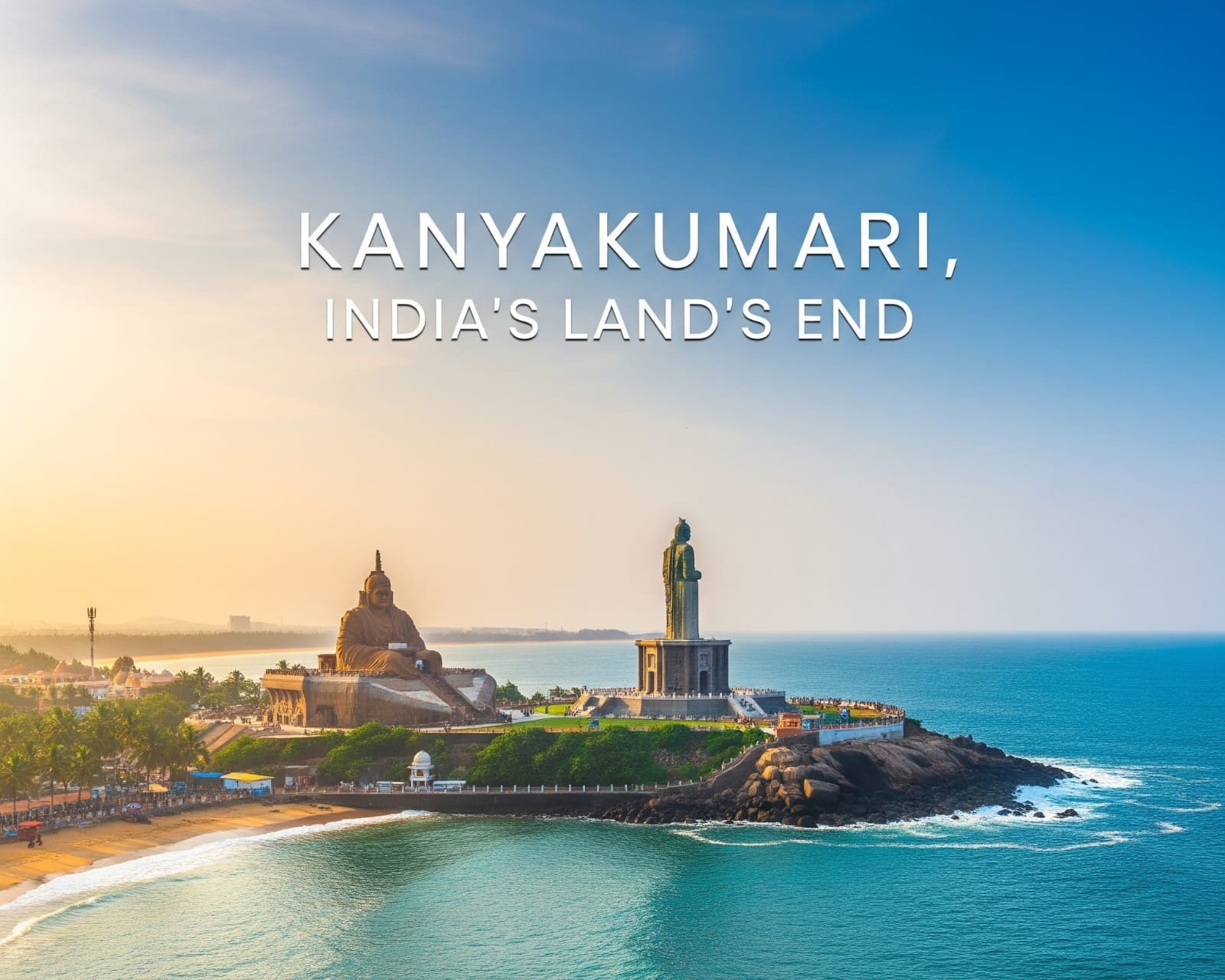At the edge of India, there’s a town where myths breathe through waves and the horizon feels infinite. But my story doesn’t begin here. It starts in Delhi—at Nizamuddin Railway Station—with two bags, one friend, and a 48-hour, 2570-kilometer train ride into silence. This was a pilgrimage to Kanyakumari, India’s southernmost tip, a journey to understand what it feels like to stand where a country ends, and something eternal begins.
For those planning this incredible journey, here is a quick overview. Kanyakumari is where three great bodies of water—the Bay of Bengal, the Arabian Sea, and the Indian Ocean—meet at the Triveni Sangam. The main attractions are the soul-stirring sunrise, the Vivekananda Rock Memorial, and the sacred Kumari Amman Temple. A crucial tip: to avoid the massive crowds at Vivekananda Rock, consider visiting in the afternoon (2–4 PM) instead of the popular sunrise slot.
The Great Indian Train Journey: 48 Hours to the South
The train journey from Delhi is an experience in itself. It’s a slow, rhythmic unraveling of the fabric of India. The chai tastes different as you cross from Uttar Pradesh into Maharashtra; the language on the platforms shifts from Hindi to Marathi to Tamil. You watch landscapes morph from the plains of the north to the rugged plateaus of the center and finally to the lush coconut groves of the south. It’s a 48-hour lesson in the country’s immense diversity, a journey that tires your body but prepares your soul for the destination.
The First Light: Sunrise at India’s End
We arrived in Kanyakumari in the early morning, fatigue settled deep in our bones, but our hearts buzzing with anticipation. We walked towards the sunrise point, joining thousands of others.
I’ve seen sunrises from Himalayan peaks and the salt flats of the Rann, but the sun rising from the sea—where three oceans kiss—hits different. It’s not just light; it’s an awakening. For a few sacred moments, the entire crowd stood still, a thousand strangers united in a single, silent ritual of watching the day be born. It was a profound reminder that some experiences are universal.
Vivekananda Rock: Where a Monk’s Meditation Changed the World
A short ferry ride takes you to the Vivekananda Rock Memorial, the spot where Swami Vivekananda meditated for three days in 1892 and attained enlightenment before his historic journey to Chicago. The rock holds two main structures: the Vivekananda Mandapam and the Shripada Mandapam, which enshrines the Sri Padaparai, a footprint on the rock believed to be that of the virgin goddess Kanya Devi.
Inside the meditation hall, a deep, palpable quietude envelops you. Sitting there, with the sound of the ocean outside, you can feel the powerful legacy of concentration and clarity that Swami Vivekananda left behind.
Kumari Amman: At the Feet of the Virgin Goddess
The Kumari Amman Temple is the spiritual heart of the town. As one of the 51 sacred Shakti Peeths, it holds immense religious significance. The temple is dedicated to the virgin goddess Kanya Devi, an incarnation of Parvati. Legend says she was to marry Lord Shiva, but he did not arrive at the auspicious time. She vowed to remain a virgin, and the rice and grains meant for the wedding feast are said to be the multi-colored sands on Kanyakumari’s beaches today. The energy inside the temple is powerful, a testament to centuries of unwavering faith.
Echoes of History: Vattakottai Fort and the Triveni Sangam
A short drive from Kanyakumari lies the Vattakottai Fort, a formidable granite coastal defense built by the Travancore Kingdom in the 18th century. Walking along its ramparts, you can see the strategic importance of this land, a place that needed to be protected from invasions by sea.
And then there is the Triveni Sangam itself. Standing at the viewpoint, you can literally see the differing shades and textures of the water where the Bay of Bengal on the left, the Arabian Sea on the right, and the vast Indian Ocean in the center converge. It’s a geographical marvel and a deeply spiritual metaphor for unity.
A Traveler’s Practical Guide to Kanyakumari
- Accommodation: We stayed at the Temple City Hotel Group. A clean, well-located hotel, it cost us ₹3600 for 2 nights on a weekday. Be aware that prices can surge up to ₹10,000 on weekends.
- Ticketing Tips:
- Vivekananda Rock Ferry: General queue tickets are ₹75, but the wait can be long. A Special ticket for ₹300 allows for quicker access. After the ferry, there’s a separate ₹30 entry fee to the rock memorial.
- Kumari Amman Temple: Entry is free, but there are special darshan tickets for ₹30. You may also find local priests offering a “shortcut” darshan for ₹100-₹200.
- Vattakottai Fort: The entry ticket is ₹25, and it closes by 6 PM.
- Where to Eat: For authentic South Indian food, Saravana Hotel is excellent. We had a wonderful meal of dosa and chapati kurma, served with incredible warmth by our server, Tanushree. In the evenings, the Beach Road comes alive with stalls selling local snacks.
A Final Reflection
The long journey to Kanyakumrari teaches you something profound. When you finally reach the end of India, you realize something strange—that endings are often quieter than beginnings. And sometimes, more beautiful too. Standing there, watching the waves of three oceans become one, you don’t feel like you’ve reached an end, but rather the start of a deeper understanding.

Leave a Reply